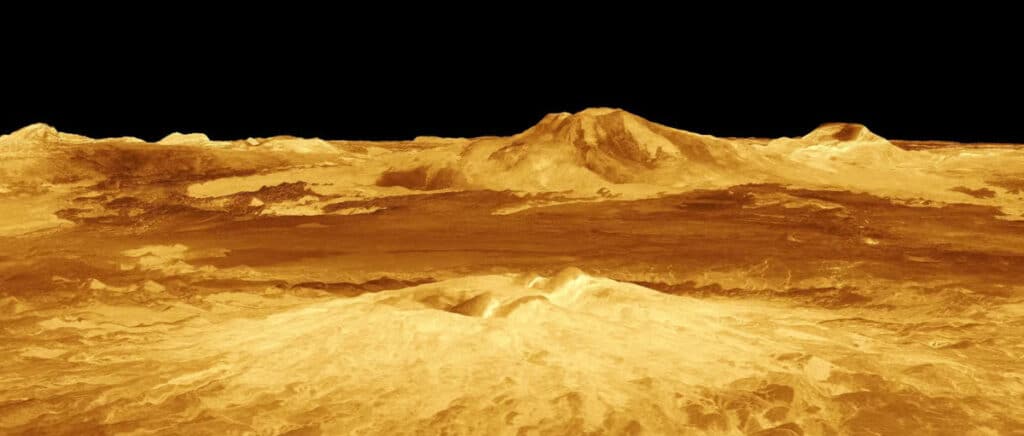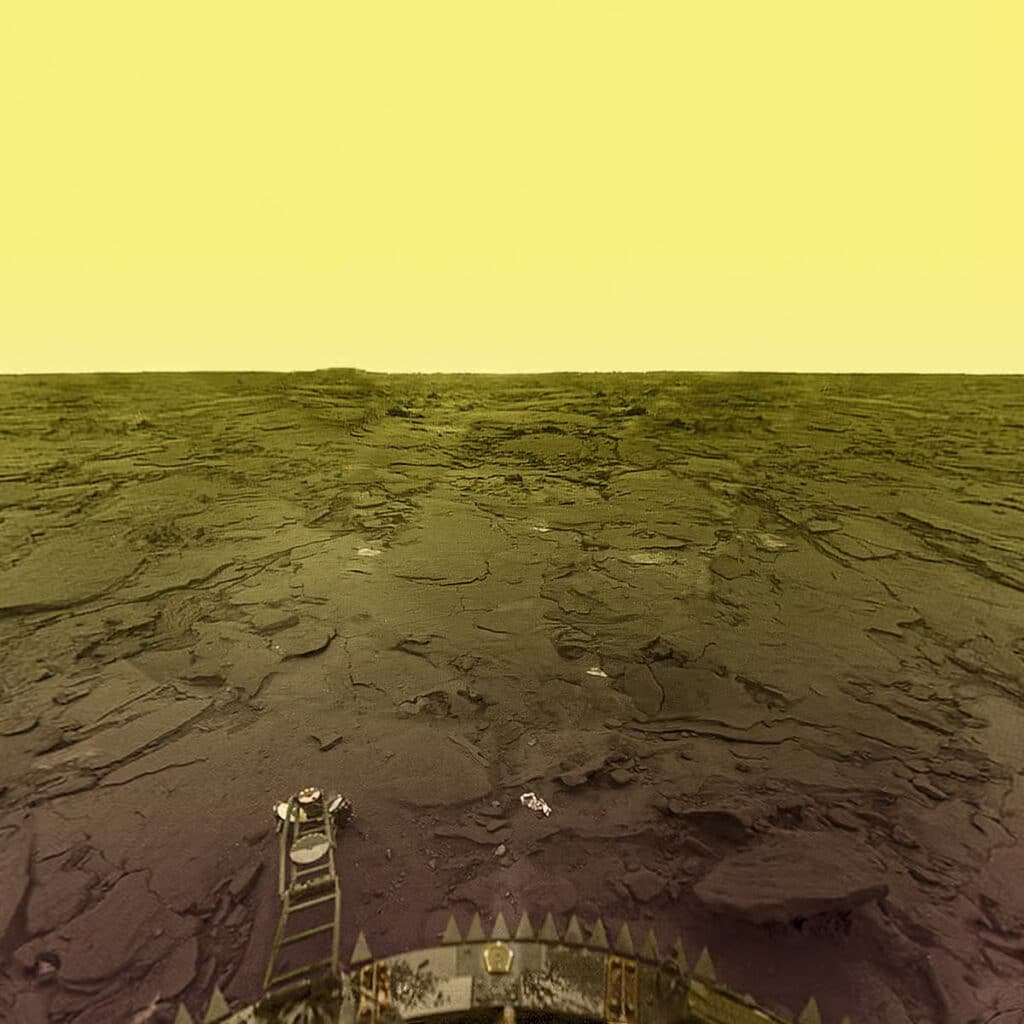Venus, often called Earth’s sister because of its similar size and mass, will soon take center stage again. Within the next decade, upcoming missions from NASA and the European Space Agency (ESA) are set to take a closer look at our scorching neighbor. Like the Moon and Mars—both candidates for future human colonization—Venus shows evidence of extensive volcanic activity. And this includes something Earth dwellers might find familiar: cooled lava tubes.
Some might still remember Haroun Tazieff, the legendary volcanologist. Probably just Gen Xers in France, really. And even they might have trouble believing what he once wrote—that back in the 1930s, volcanism was considered a minor geological curiosity.
Tazieff helped flip that notion on its head. Today, we know volcanism isn’t just a major force on Earth, tightly linked to plate tectonics, but it also plays a pivotal role across our solar system.

This image was obtained from radar data from the Magellan probe, which observed and mapped the surface of Venus from August 1990 to October 1994. Magellan’s observations established that the surface of Venus is generally young, with an average age of a few hundred million years at most. Indeed, few impact craters have been observed. It is also noted that the surface is characterized by significant volcanism, since the entire surface of Venus is made up of volcanoes, lava flows, calderas, and domes. However, during the four years of Magellan radar observations, no plumes, ash, or significant changes to the surface of Venus were detected. There is therefore a debate about the reality of current or recent volcanic activity on Venus. © NASA
A Soviet legacy on Venus
We’ve understood this even better since the Magellan probe mapped Venus in the early 1990s. That mission revealed a surprisingly smooth surface with very few impact craters, but loads of volcanic formations.
Thanks to the Apollo missions, we’ve learned how to use crater density to date a planet’s surface. The logic? The solar system’s early days were full of collisions, but the frequency of impacts has dropped sharply over the past 4.5 billion years. So fewer craters generally mean newer terrain.
Venus’s volcanic plains, then, are relatively recent—possibly just a few hundred million years old. Maybe even younger, some have long suspected.
Though early American Mariner missions gave us initial glimpses, it was the Soviet Venera probes that really delivered the goods. Venera 4 conducted the first direct study of Venus’s atmosphere in 1967. Venera 7 landed in 1970. And Venera 13 finally sent back dazzling images of the planet’s surface in the early 1980s.

Processed with modern technology, this image originally comes from those taken on the surface of Venus by a Russian Venera probe. The soil is clearly volcanic. © Don Mitchell
Peering beneath Venus’s crust
The debate over whether Venus still hosts active volcanoes continues. But in recent years, clues have been piling up. So there was plenty of buzz during the 2025 Europlanet Science Congress in Helsinki when planetary scientist Barbara De Toffoli and her team from the University of Padua dropped a revelation.
According to them, they’ve uncovered the first solid evidence of lava tubes on Venus—structures strikingly similar to those found on the Moon, Mars, and Earth.
Their research draws on radar and topographic data from earlier missions. The focus? Long chains of volcanic formations, including volcanoes with craters over 60 miles wide. The team believes Venus could be hiding some of the largest underground cavities in the solar system.
There’s still work to be done, but hope is high for the upcoming ESA EnVision mission, set for the 2030s. It’ll carry the Subsurface Radar Sounder (SRS), a tool capable of detecting formations buried hundreds of meters beneath Venus’s crust.
A presentation of the EnVision mission. © ESEO
Pit craters and buried potential
Venus is a no-go for humans—for now. The surface is brutally hot, and even our toughest robotic probes only survive for a few hours. Which is a shame, really. If it weren’t so hostile, those massive lava tubes—assuming they’re real—could make great shelters.
Just like on Mars or the Moon, any future outpost would need to be shielded from cosmic radiation. Whether it’s the Sun throwing a tantrum or deep-space rays quietly pummeling us, long-term exposure is a cancer risk. Lava tubes could offer natural protection—ready-made bunkers for permanent bases.
A complex, winding network of channels may exist just beneath the Moon’s surface. These lava tubes, produced by underground magma from ancient volcanoes, are protected from solar radiation and may contain secrets about the history of our Solar System. © NASA
On Earth, lava tubes form when the surface of a lava flow cools and solidifies while the molten rock beneath keeps moving. Once the lava drains away, a hollow tube is left behind. Weak spots in the ceiling sometimes collapse, forming pits—known as pit craters in Hawaii. Some tubes feature skylights at regular intervals. Others cave in entirely, creating winding rifts like those seen on Lanzarote in the Canary Islands.
These natural cavities have captured the imagination of lunar colonization dreamers.
Lunar caves to shield a biosphere from cosmic radiation
© Jared Pike, communications specialist for Purdue University’s School of Mechanical Engineering
Did you know?
Back in 1969, geologists proposed that some of the Moon’s long rilles—stretching for hundreds of miles—might be collapsed lava tubes. Similar to those in Hawaii or Iceland, these were thought to be created by rivers of molten rock that lowered over time as eruptions subsided. Some rilles were miles wide.
At the time, scientists believed such tubes couldn’t remain stable if wider than 1,300 feet. But more recent data—from missions like Grail, Selene, and the Lunar Reconnaissance Orbiter—suggest otherwise. We may be looking at stable lava tubes over a mile wide.
A Purdue University team revisited the subject in the journal Icarus, concluding that tunnels between one and three miles across could indeed hold up. On Earth, similar structures top out around 100 feet wide due to stronger gravity.
These lunar lava tubes, leftovers from a more volcanically active past (and possibly still just a little active), could remain structurally sound even if their roofs are just six feet thick.
Ready-made homes for lunar explorers
For those dreaming of major lunar colonies, these tubes are tantalizing. The Moon has no atmosphere and no magnetic field to guard against cosmic rays, especially during solar storms. So future settlers will likely need to live underground.
Some have proposed using lunar dust—regolith—to make concrete and cover astronauts’ habitats. But if lava tubes are already there? That’s a huge shortcut.
Imagine deploying a massive biosphere inside one. Lighting for crops is still a challenge, sure. But shelter? Solved.
Calculations show that a lava tube over a mile wide, with walls 130 to 1,600 feet thick, would be insulated from the Moon’s extreme temperature swings and hold steady at around -4°F.
The key would be finding such structures near the Moon’s polar craters—places where frozen water is likely hidden. Oxygen can be extracted from heated lunar rocks using solar energy, but water? That’s harder to come by. And we’ll need plenty of it to support a large human population growing its own food in a self-contained biosphere.

Laurent Sacco
Journalist
Born in Vichy in 1969, I grew up during the Apollo era, inspired by space exploration, nuclear energy, and major scientific discoveries. Early on, I developed a passion for quantum physics, relativity, and epistemology, influenced by thinkers like Russell, Popper, and Teilhard de Chardin, as well as scientists such as Paul Davies and Haroun Tazieff.
I studied particle physics at Blaise-Pascal University in Clermont-Ferrand, with a parallel interest in geosciences and paleontology, where I later worked on fossil reconstructions. Curious and multidisciplinary, I joined Futura to write about quantum theory, black holes, cosmology, and astrophysics, while continuing to explore topics like exobiology, volcanology, mathematics, and energy issues.
I’ve interviewed renowned scientists such as Françoise Combes, Abhay Ashtekar, and Aurélien Barrau, and completed advanced courses in astrophysics at the Paris and Côte d’Azur Observatories. Since 2024, I’ve served on the scientific committee of the Cosmos prize. I also remain deeply connected to the Russian and Ukrainian scientific traditions, which shaped my early academic learning.


